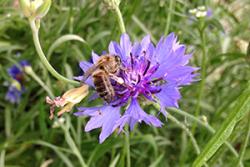New long-range micro backpacks for bees could provide vital information
 Harnessing the bee’s own electrical energy is the solution proposed by an exciting new project to create a lightweight and long range bee-tracking device.
Harnessing the bee’s own electrical energy is the solution proposed by an exciting new project to create a lightweight and long range bee-tracking device.
Bee populations, our vital crop and fruit pollinators, are in serious decline; their survival faces challenges on several fronts, insecticides and varroa mites to name a few.
Devices that enable the insects to be tracked could reveal a great deal. Having such data could, for example, show us where bees are collecting nectar and how far they’re travelling as well as assist in resolving how neonicotinoid and other similar pesticides interfere with bees’ navigational abilities.
However, existing bee monitoring devices face limits in their applications. Three major challenges need to be overcome to be truly useful: their weight, range, and how long their power source lasts.
A �鶹��ý����� ecologist has got together with a microelectronics expert at the University to bring cutting edge micro-technology to resolve these problems to be able to track bees over their whole range.
Paul Cross, Senior Lecturer in the Environment explains:
“The ability to track bees or other insects over their entire range will be useful in various circumstances. Neonicotinoids and other insecticides, for example, affect the bee’s ability to navigate. The ability to track them over long distances can help us work out how the nicotinoids are affecting their direction finding. Other applications include tracking Asian hornets (a serious threat to many bee species) in Europe with a view to controlling or eradicating them before it’s too late.”
The proposed solution does away with the heaviest part of existing devices- the battery, to create a self-sustained tracking device estimated to weigh only a third of the bee’s body weight (most current devices weigh more than the bee). This also resolves the current problem of longevity, as current transmitters are limited by the battery lifetime.
As Paul Cross explains, “This really would be akin to a bee wearing a rucksack- as opposed to carrying the equivalent of the kitchen table and chairs as at present!”
Cristiano Palego, Senior Lecturer in Smart Sensors & Instrumentation explains how the team intend to capture and capitalise on the electrical energy created by the bee’s wing movements- and even harvest electricity from the friction created as the bee moves through the air, to power a lightweight transmitter.
The device they intend to create for the bees will weigh less than two grains of rice (50 microgrammes) and will be the size of a match head.
They intend to use a mobile receiver to track and follow the bee’s transmitted signal as it moves within the landscape. The transmitted signals will have a range of up to 100 metres and be able to track the bee over its entire foraging range.
The initial project is to be funded as a Knowledge Economy Skills Scholarships (KESS) Programme. The partner organisation is The Apiary Enterprise Limited, who are keen to fund research into honey-bee tracking in both temperate and tropical environments to identify the foraging range of the bee under differing climatic and environmental conditions. This will provide the company with more robust viability assessments before establishing new apiaries.
Publication date: 14 December 2015
